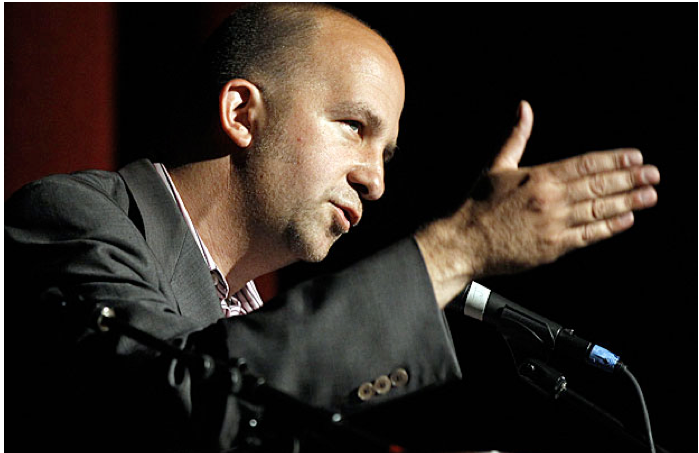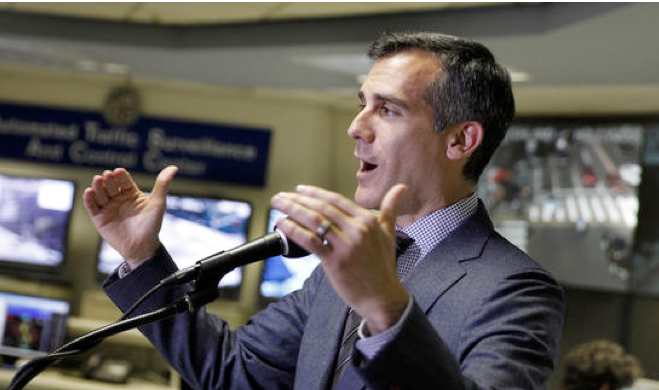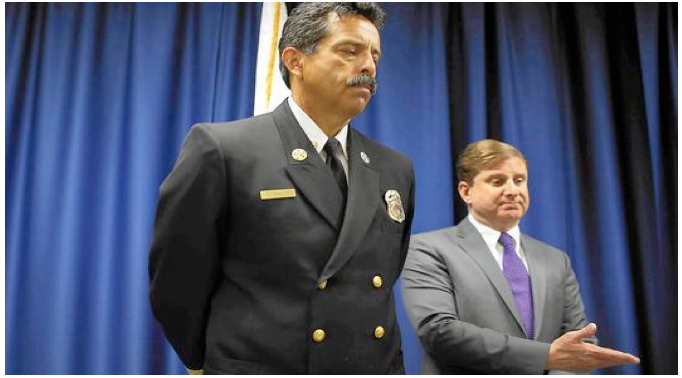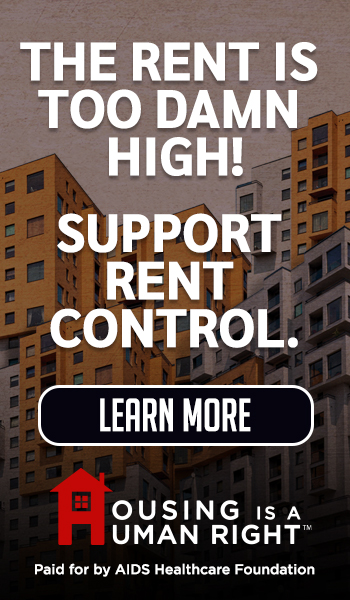PLATKIN ON PLANNING-Mr. Mayor, other than reelection, you have a tough assignment, and it is much more than finding unusual photo ops. You are the mayor of the second largest city in the United States, and one of our planet’s creative capitals. Los Angeles’ population is approaching 4,000,000 people, and 2,000,000 work in Los Angeles. City Hall has a work force of 50,000 employees and an annual budget of at least $9 billion. It covers over 550 square miles, and has the largest and most congested street system in the United States. (Photo above: Los Angeles Mayor Eric Garcetti.)
This is why the public – knowing your fine education, extensive political connections, and obvious hopes for higher office – wants you to lead. They don’t want a Mayor who just echoes the talking points of financial backers from the real estate sector, as you did last week at an anti-Measure S press conference.
This is when you became the lead mouthpiece for some of the major real estate players that the Los Angeles Times exposed as engaging in soft-corruption. According to the Times, these companies engage in City Hall pay-to-play to obtain spot-zones and spot-General Plan Amendments for their unplanned mega-projects.
As I review your comments, it boils down to a basic claim. A deregulated private market can do a better job in addressing such pressing issues as homelessness and high rents than preparing, adopting, implementing, following, and updating a carefully prepared and monitored General Plan.
Mr. Mayor, when you return from you photo-ops, just look at that Los Angeles that will be maintained if your advocacy against Measure S prevails. All the dire things you predict with a Measure S victory are already widespread in today’s Los Angeles. Your case that conditions will get better by maintaining the status quo is just not credible. The evidence is right in front of us. We only need to look at nearby cities with current General Plans that they adhere to, like Pasadena and Santa Monica. Without the spot-zone changes and spot-plan amendments stopped by Measure S, these cities demonstrate that good planning can address a housing crisis, a well-maintained infrastructure, and robust economic activity. They have no need to give away the store in exchange for handouts from developers.
Now, let’s get into the specifics of the Chicken Little sky-is-falling claims about Measure S.
1) No, Mr. Mayor, Measure S does not stop housing construction.
Nearly all housing, including apartments, in Los Angeles is built by-right. It does not require a spot-zone change or spot-General Plan Amendment from the ever-obliging City Council. The projects requiring these special City Council ordinances, like the Caruso project on LaCienega, are a small percentage of residential construction projects.
The underlying problem is that because of economic inequality, few people can afford the rents of these new apartments, especially the luxury ones that Measure S opponents, like you, so venerate. There is also no evidence that a glut of luxury units, which is already happening in Downtown Los Angeles, cause landlords of less expensive apartments to lower their rents to make them affordable for the rest of the public.
This is because the "free" market will never build more than a minuscule amount of affordable housing through programs to privatize affordable housing, like SB 1818 (density bonus). The real way to expand the supply of affordable housing is for the public sector to build affordable housing, and that requires government programs, such as Measure HHH, an approach consistent with Measure S.
2) No Mr. Mayor, Los Angeles is not on verge of a population boom and must therefore open the floodgates to unplanned luxury apartment construction.
The General Plan Framework, and the City's population prediction was 500,000 people too high. At present, LA has 3.9 million people, and it is only growing by about 10-20,000 people per year. It is doubtful LA will even reach the 2010 figure by 2050.
The Framework and the prior AB 283 project also concluded that LA could reach a population of 8 million residents based on existing zoning. This clearly means that LA’s existing zones and plans do not present any barriers to (legal) housing construction.
3) No. Mr. Mayor, Los Angeles does not have a shortage of lots whose plan designations and zones permit apartment construction.
If or when LA reaches the Framework’s demographic forecast, the city will have more than enough existing zoning to accommodate that population. Los Angeles has no need for the spot-zones and spot-plans you champion. For example, every commercially zoned parcel in Los Angeles already allows R-4 apartment houses. This means that all of LA's long commercial corridors, such as Vermont, Van Nuys, Pico, and Washington, could accommodate three story apartment buildings, including optional ground floor retail. They would not require any zone changes or plan amendments. And with SB 1818 incentives, these new buildings could incorporate four or five stories of apartments.
4) No Mr. Mayor, Measure S does not stop high density housing at subway stations.
For example, on Wilshire Boulevard, where METRO is constructing the Purple Line Extension, existing plans and zones allow unlimited height. If, for example, the Caruso project were built one-half mile to the north, at LaCienega and Wilshire, it would not need to all those planning entitlements you support. It would also be adjacent to a future subway station. Furthermore, building luxury housing near subway or light rail stations does NOT create affordable housing. There is no supply and demand linkage between these totally disconnected parts of the housing market.
5) No Mr. Mayor Los Angeles does not have high rents because of its existing zoning.
Rents are high because of four other reasons:
- LA’s rent stabilization ordinance is weak, and it needs to be amended to stop vacancy decontrol and automatic annual rent increases.
- Congress eliminated nearly all Federal affordable housing programs, beginning in the 1970s.
- The California State Legislature dissolved the Community Redevelopment Agency, which spent 20 percent of its budget on affordable housing.
- In Los Angeles the real estate developers who fund City Hall campaigns do not want to build by-right affordable housing and market housing where it is permitted because they make fatter profits through luxury high rise buildings. Their business model, not zoning, is the barrier.
6) No Mr. Mayor, the purpose of updating LA’s General Plan is not to facilitate the wishes of real estate investors.
The reason we need to update the General Plan is to address climate change, determine where there is adequate infrastructure and services for existing and future development, where geology and hydrology affect the built environment, and where there is the greatest demand for housing, jobs, infrastructure improvement, and public services.
7) No Mr. Mayor, Measure S does not prevent the City of Los Angeles from using City-owned property for affordable housing.
This program has been on the books since the 1980s, initiated by your predecessor, Mayor Tom Bradley. The City Council then hired consultants to identify thousands of city-owned properties, but in the intervening 30 years only the air rights over several parking lots have been used for affordable housing.
Now, coming out of a Rip Van Winkle sleep, your administration has resurrected this Bradley-era program, selecting 11 out of 9000 separate parcels that may or may not be stopped by Measure S. The thousands of parcels that would NOT be blocked by Measure S have been kept out of view, and there are no details on what is actually proposed for the 12 sites since, so far, there is only a Request for Proposals (RFP).
If this results in serious proposals, and if they are for 100 percent affordable housing, and only need a zone change, Measure S would not make any difference.
Meanwhile, stop scraping the bottom on the barrel to find a few hypothetical conflicts with Measure S. It is high time for you to direct your staff to identify which of the remaining 8,993 City-owned parcels are already suitable for by-right affordable housing construction.
LA’s Cycle of Decline
Mr. Mayor, the approach to governance revealed by your public opposition to Measure S draws Los Angeles into cycle of further decline. In LA, with all it complexity and energy, City Hall is now just governing by the seat of its pants, lurching one way or another depending on which real estate honcho walks through the mahogany doors. A diametrically different approach, one based on the careful planning and monitoring mandated by Measure S, is the leadership Los Angeles now needs.
(Dick Platkin is a former Los Angeles City Planner who reports on local planning issues for City Watch. Please send any comments or corrections to [email protected].) Edited for CityWatch by Linda Abrams.











